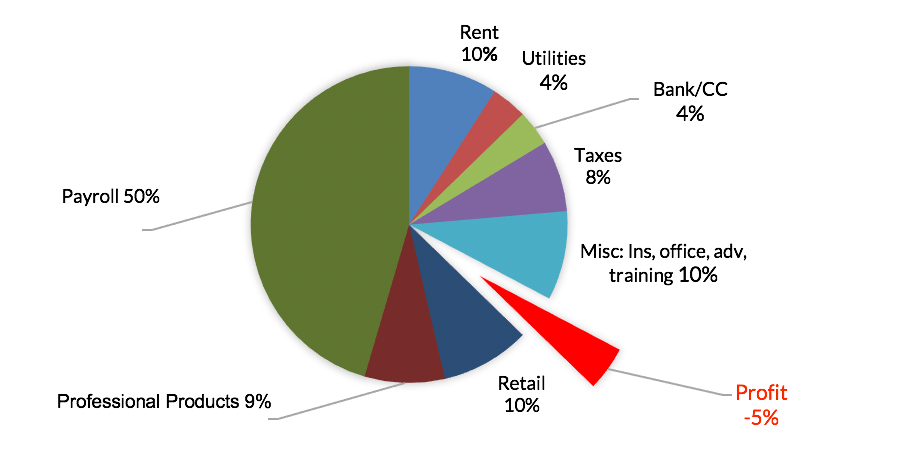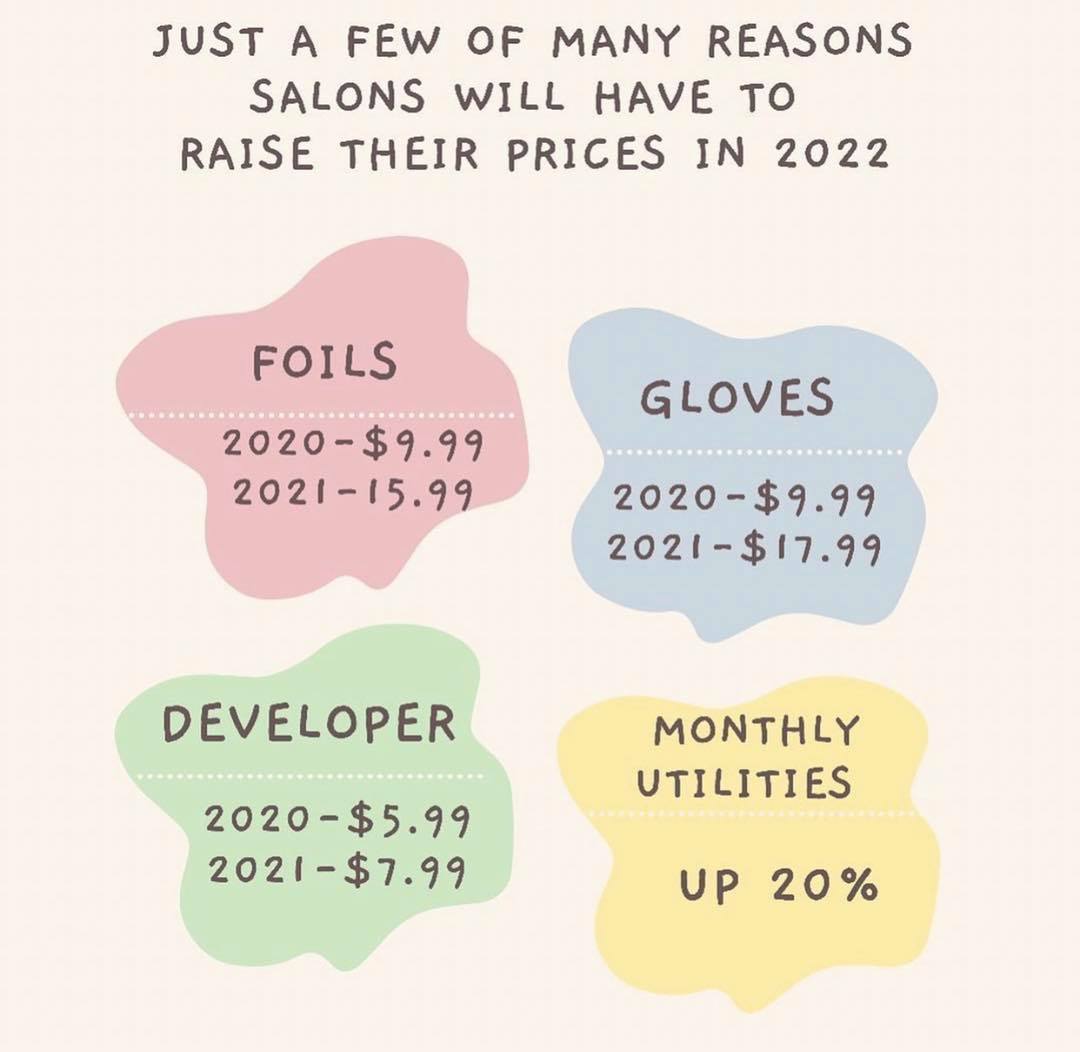Five Foolproof Ways to Slash Costs and Maximize Salon Revenue
Salon ownership can be very fun and rewarding, but it’s rarely easy. On the good days, your stylists feel loved and supported, and your clients feel that love too. On the bad days… well, all salon owners get negative feedback sometimes.
As the salon owner, not only do you have to support your staff… you have to watch your bottom line like a hawk, too. And if you’re a salon owner paying yourself as an employee, there’s a 90% chance your salon turns a NEGATIVE 5% profit every month.
According to research by Salon Ops, it’s true. Here’s their exact breakdown of an average hair salon’s monthly expenses:

As you surely know, a -5% profit margin simply isn’t going to work. And most salon owners don’t have a college degree of any kind, let alone a Business or Finance degree. What can you possibly do?
Don’t panic. There are five common problem areas for salon profit margins… and once you’re aware of them, you’ll know exactly how to maximize salon revenue.
The Five Most Common Problem Areas In Salons
1. Research your retail. Are your salon shelves or back room full of old, unpurchased product? Do your stylists ever say they “almost sold a client shampoo and conditioner… but the products were out of stock”?
These are both telltale signs of an inventory that needs attention. This step takes a bit of number crunching, but the payoff will be almost instant.
You (or a staff member with inventory experience) need to take inventory. Record exactly how many you have of each individual product, including different sizes of the same product.
And leave no stone unturned… Don’t just count what’s on the shelves. If you have boxes of backstock anywhere, account for all of it. Finally, be sure to record the products you are currently sold out of.
Salon retail is an often-overlooked part of salon ownership…
but professional and retail products account for 19% of the average salon’s
expenses. Meanwhile, the most successful salons make 20% of their total profit
from retail sales. Do you see how important retail is when you're trying to maximize salon revenue?
Once you have your inventory accounted for, look at your product order receipts. Do you have any retail products which haven’t sold a single unit in the past 90 days? If so, move it! Put it on a huge clearance sale or ask your vendor if you can exchange it for a product which sells well for you.
Freeing up shelf space and removing clutter sets you up for the next step, where you’ll make your inventory work for you.
2. POS system? POS-itively necessary. These days, most salon software is all-in-one. This means your staff uses one ultra-convenient system to:
- View their own sales and timing statistics, weekly or monthly
- Add notes about client’s color formulas and hairstyle
- Track how often clients visit and their average spend per visit
- Schedule appointments
- Process service and retail sales
- Create customer profiles which track service and retail purchases
- Allow customers to book appointments online
- Track current inventory
- Calculate when you need to reorder and order quantities
It’s true! Salon software embodies the idea of “working smarter, not harder.” Now that you have your inventory accounted for, input everything into your POS software.
Now, every time retail is purchased, it will be noted on that customer’s profile. Over time, you’ll see how often they visit, how often they purchase, and opportunities for other product recommendations.
You’ll also see how quickly your staff goes through backbar products. Never again will a stylist talk up their favorite product, just to find an empty bottle when they want to demonstrate it for their client.
Your software will tell you how much to order of every product, and when. After about two weeks, you’ll get a “shopping list” detailing how many units you need to order by a specific date to avoid selling out.
This is so crucial when you're trying to maximize salon revenue. Your staff will have more time to clean, do laundry, update client notes… all the little things that seem to fall through the cracks in a busy salon. You’ll throw away or heavily discount far less product because you’ll know exactly what’s selling well and what’s not.
Now that your inventory is up to snuff and you’ve got software doing the heavy lifting, it’s time to go all-in online.
3. Embrace the digital age. Your POS software is running like a dream, and it’s easy for your staff to use. Now, you’re going to utilize this technology to its fullest.
Salon software, for the most part, has integrated online booking. This allows your customers, whether new or returning, to book appointments on your website… without taking any of your staff’s time.
You’ll tell the system how long each service takes, which stylists provide which services, and finally each stylist’s schedule. Then, clients will click one button on your website. They’ll be able to pick the day, time, service, and stylist they’d like to see. The system will book it, and the appointment will immediately appear on your receptionist’s computer screen.
There’s no risk of being double-booked because computers exchange info lickety-split. Meanwhile, your staff drops their tasks to answer the phone far less often. You may be able to employ support staff part-time rather than full time… or give your full-time receptionist an impactful project that'll help maximize salon revenue.
Finally, online booking allows your clients to book appointments around the clock. You’ll be surprised how many folks hop online at 6am or 9pm to book their appointment. Your stylists will often find their books have filled overnight, and you didn’t have to employee a 24-hour phone operator.
Now that your stylists are busier, you need to take a hard look at your service profit margins.
4. Think about efficiency. What if your stylists are busier on average, but your profit margins aren’t moving much? This is more common than you think, and very straightforward to solve.
Using your POS software, calculate the actual profit margins of each service. The pandemic caused prices of basic supplies like foils and gloves to increase by nearly 80%. Have you adjusted your service prices to account for this?

Or, do you have any stylists who are slower than most? If they spend 3 hours providing a service someone else can do in 2 hours… and both stylists charge the same amount… that’s not efficient!
Of course, you can’t charge a client more for their color service because their stylist is slow. Instead, work with that stylist to get their timing where it needs to be.
Look at every service you provide. Are stylists charging clients for extra bowls of color as they should? Are they charging for a style with hot tools, or sneaking it in at the basic blowout price?
You may need to spend a few days in the salon to notice any of this behavior, but it’s worth every second.
Now you know if you need to increase service prices, and if you need to retrain any staff members. You know exactly which services allow you to maximize salon revenue, and which are dragging you down.
It's time to discuss your findings with your staff.
5. Get your staff on the same page. Address these areas in the order listed, and this final step should be a cakewalk. At this point, your staff:
- Offered input and felt heard while you worked through salon problem areas… increasing their loyalty to you.
- Always has the right retail products in stock… so they feel professional, in control, and supported.
- Loves the all-in-one booking and POS system you purchased… because it saves so much time during busy shifts.
- Appreciates the new online booking system… because they aren’t leaving their clients to answer the phone nearly as often.
You’ve proven your dedication to your staff. They respect and listen to you… while you turn real profits every single month. Now it’s time to call a staff meeting and explain how they can help maximize salon revenue.
Did you know that on average, salons waste 40% of their color stock? Yes, the average salon throws away two of every five color tubes… due to stylist over-mixing. That’s hurting your ability to maximize salon revenue!
Explain to the entire staff that you need them. You need each and every one of them to make your salon the best it can be, and a great place to work… but you need their help. You aren’t working in the salon every day, but they are.
Share the statistic about color waste. Calculate, based on your cost per color tube, how much money is being washed down the drain every month… and then tell them. Break it down to the daily cost too, so they think back to the last time they wasted a bowl of color.
Some or all staff members may be sheepish to admit they’re part of the problem, so frame it as a free training opportunity. If the color waste is truly an accident, and truly due to stylist inexperience… book an in-salon class.
The class may cost you a bit, but in just an hour, every stylist will be an expert at mixing the right amount of color. You will be reaping the financial benefits the very next day… and your stylists will appreciate the education opportunity. It’s a win-win-win! For you, for your stylists, and for your salon.
Color waste is typically the biggest contributor to overall waste, but there are others. How often is the laundry done? Are the loads always full loads, or is your water bill sky-high due to repeated cycles with just a couple towels? Talk to your receptionists and any other support staff to find ways to slash salon costs.
The big goal is to get everyone on the same page about the importance of reducing waste. It benefits the environment, your bank account, and even your staff… they’ll run out of supplies far less often if they commit to reducing waste!Now You’re Ready to Maximize Salon Revenue
Making any kind of change to your business can be a daunting task… especially if you or your staff has developed expensive “bad habits” in the salon.
Try to be fair with yourself and your staff. Scientific studies going back as far as 1960 have proven old habits die hard. The earliest study by Dr. Maltz showed it takes at least 21 days to form a new habit, on average.
You and your staff are not only forming new cost-saving habits… you’re also breaking the old expensive habits. That’s a lot for anyone to handle! Try to give yourself and your staff a month before you compare the numbers.
If there’s absolutely no change in your profit margin, odds are the staff didn’t take your message to heart. It’s unfortunate, but it happens sometimes. If this should occur, incentivize them in a way that costs you almost nothing.
For example, looking at the numbers from your new POS system, it will be obvious which shifts (and which staff members) aren’t pulling their weight. Reward the ones who are with a gift card for a coffee, or a candy bar… any item which costs a few dollars. That’s a drop in the bucket compared to the reduced expenses you’ll enjoy once everyone is on the same page.
If your profit margins do grow (and they should!) you’ll still want to keep an eye on your numbers. Let your staff know what a great job they’re doing and how much you appreciate the team effort. Continued positive feedback will condition them to stick to these new habits… Pavlov proved that in his famous 1897 experiment, and it’s still true today!
Do you have questions about these steps, or a staff member who won’t get with the program? Sound off in the comments!
Cheers to your success,
Shelby Dennis
Your freelance beauty copywriter
P.S. Want to read more of my B2B copywriting samples or beauty copywriting samples? Click here to check out my writing portfolio.


Comments
Share your question or comment in the box below!